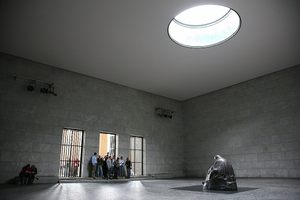
Along the grand avenue of Unter den Linden in Berlin stands a stout neoclassical memorial. Set a few meters back from the street, and catty-cornered from the State Opera and the expanse of Bebelplatz (the site of Berlin’s May 1933 book burning), the memorial can be easy to miss. Yet, a visit to the poignant memorial is not only resonant, but also enables visitors to trace how the German culture of remembrance has evolved since the early nineteenth century. The monument is called the Neue Wache, or the New Watch House.
The Watch House was built between 1816 and 1818 by Prussian Surveyor General Karl Friedrich Schinkel to house the king’s soldiers while commemorating Prussian heroes from the Napoleonic Wars. The Doric columns and frieze centered on Nike, the goddess of victory, while statues of Prussian military heroes Gerhard von Scharnhorst and Friedrich Wilhelm von Bülow stood sentinel outside.
In 1931, the Neue Wache was repurposed by architect Heinrich Tessenow—a mentor of Hitler’s eventual city planner, Albert Speer—who gutted the interior, opened an oculus to the sky, and placed a black granite block with a German oak wreath to honor German soldiers from the Great War. During Nazi rule, a cross was added to the wall, symbolizing the regime’s exclusion of Jewish servicemen.
After the monument and much of Berlin were destroyed during World War II, the Socialist Unity Party of Germany—which governed the German Democratic Republic—restored the memorial in the 1960s and later rededicated it to the victims of fascism and militarism. A glass prism housing an eternal flame was placed at its center, while an unknown soldier and nameless concentration camp victim were buried inside the monument, surrounded by soil from Second World War battlefields and concentration camps.
In 1993, three years after Germany reunified, President Richard von Weizsäcker re-christened the Neue Wache as a National Memorial to Victims of War and Dictatorship. For its centerpiece, Chancellor Helmut Kohl selected a scaled-up version of “Pietà” by German artist Käthe Kollwitz, whose son Peter fell in World War I. The grieving mother symbolizes the personal pain and suffering at the heart of wartime loss, while a simple inscription, “Den Opfern von Krieg und Gewaltherrschaft”, or “To the victims of war and tyranny”, invites visitors to bring their own sense of loss. In its simplicity, the Neue Wache reminds visitors of the depths of personal grief.

